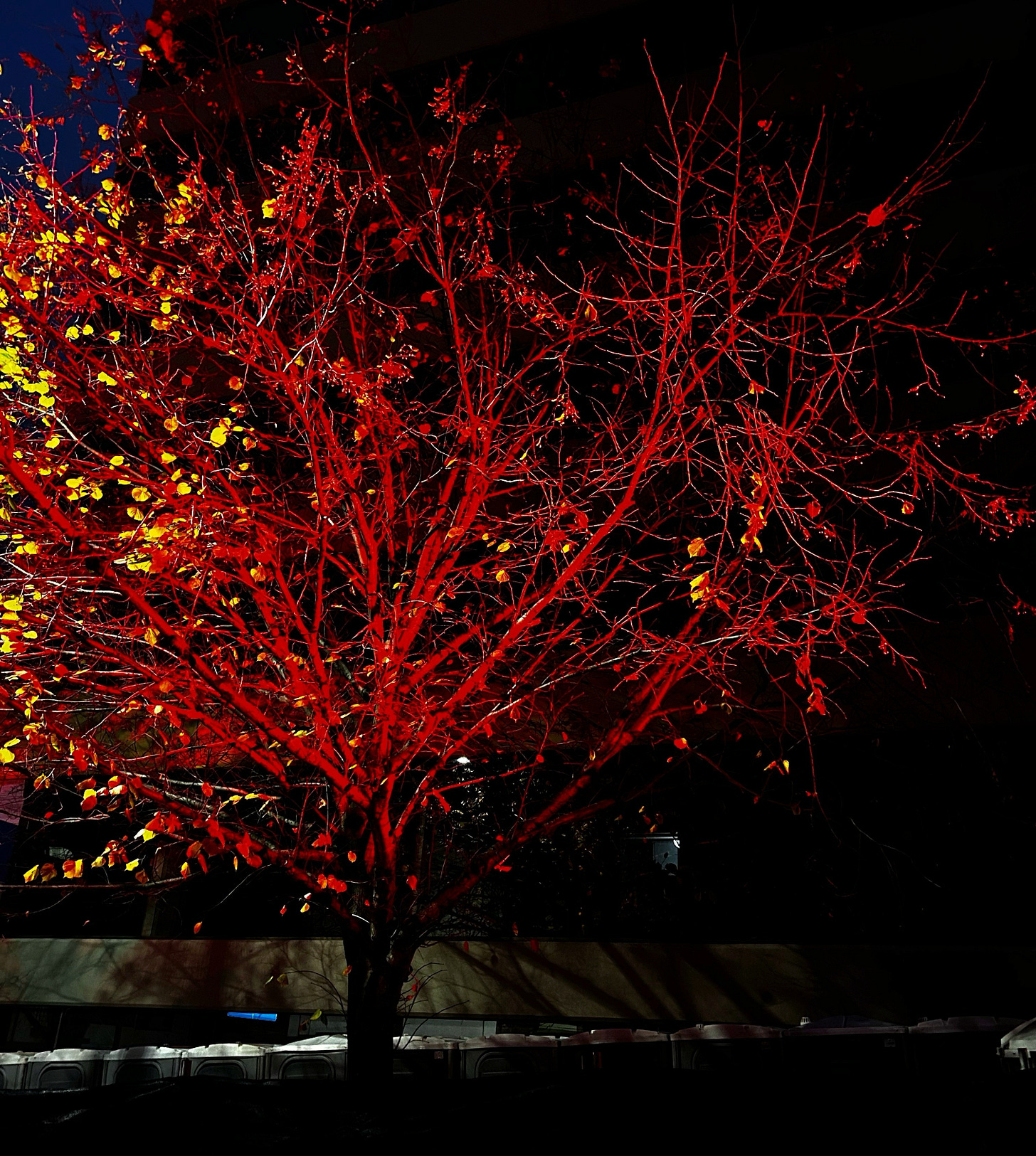An update - the kitchen, the garden, and three (mostly) food-related snippets I’ve discovered.
It’s just turned 4.30 in the afternoon on a wet, grey day. It’s almost dark; the winter solstice is not far away. It feels like it should be dinner time. It’s nearly 5 pm by the time I pop into the local shop. Town is almost deserted, just a couple of cars parked, the fuzzy glow of the street lights tempered by the fog.
Whilst things are quiet in Geeveston, in Hobart, the city is glowing red. Driving into town before dawn, the red arch of the Tasman Bridge is visible. On the ground, trees are lit up, shop window displays are both quirky and red, and the waterfront is irreverently decorated with red crosses mounted every which way. Dark Mofo, a pagan festival of darkness, is back this year after a year’s hiatus. The oft-controversial festival celebrates winter with a diverse program of events from acts of ‘musical madness’ to crashing cars and the burning of the ogoh ogoh. This Balinese ritual begins with a procession of the ogoh-ogoh, this year a giant sculpture of the endangered maugean skate1, which is then set alight.
And of course, there is food. The Winter Feast held in a transformed wharf on the Hobart waterfront is a showcase of Tasmanian produce, chefs, wine makers and distillers. Each year a guest chef develops a Dark Mofo menu. This year, Niyati Rao, who started her profession at Noma and more recently at Ekaa in Mumbai is offering among other things, char-grilled wallaby wings with gochujan glaze and urchin with pickled beetroot and spiced broth. Tempting as it is to hibernate at this time of year, there are plenty of reasons not to stay home over winter.
Winter equals porridge. I recently visited my sister, and we were discussing porridge and whether we were on team porridge made with milk or porridge made with water. My mother eschewed porridge made with water, and so we grew up eating creamy porridge made with milk, usually topped with evaporated milk and brown sugar. As a result, I’ve been strictly on the porridge made with milk team.
Late last year, when we travelled around the United Kingdom, I did, on occasion, have porridge for breakfast. The one I had at the Lord Crewe Arms in Blanchland, a place well worth stopping in, stuck in my mind. It didn’t live up to the expectations of the menu - porridge served with cream and a glug of whiskey. When I politely enquired where the whisky was, I was informed that it was in the porridge. I wasn’t convinced, and really, if I’m opting to have whiskey at breakfast, I want to know about it. But it did get me thinking about porridge made with water.
So with the advent of porridge season, I recently decided to make it with water, fully expecting to take one bite and announce that I was going back to milk. Except I didn’t. Admittedly, I think the restrained swirl of cream on top helped, and while I haven’t yet doused it with a dram of whiskey, it could be a weekend breakfast in the future.
On that same trip, we stopped overnight in a little Scottish village called Carrbridge. It is a dot on the map with very little to see or do, but it is the home of the Golden Spurtle and the World Porridge Championships. This quirky competition has recently been the subject of an Australian documentary, currently screening at the Sydney Film Festival, but will be released more widely later in the year. I’m looking forward to seeing it. For the purists wanting to make porridge the traditional way, competition finalist Toby Wilson gives some tips. And if you’re looking to up your porridge game, you might find some inspiration here.
The first flight I remember taking was when we migrated from England to Australia. I was eight years old and enamoured with the whole experience, not least the food. It sparked my enduring love of airline food! I know that anyone who has even a passing respect for food should never admit this. It’s a bit like a chef who has a secret hankering for McDonald’s. My guilty pleasure is airline food. Perhaps it’s the association with travel, all that ‘feel good’ vibe that goes with holidays. But really, I just like the food. I like the precise portions, I like the little packets of bits and pieces, I like how it is all carefully arranged on the tray. Admittedly, food on planes is not what it once was. That first trip, even in economy, involved printed menus and proper cutlery (it was a long time ago!) and grapefruit segments topped with a maraschino cherry (I think this is where my love of maraschino cherries also started) for breakfast. Such sophistication!
Prior to 1978, when airline deregulation came into being, eating on a flight was considered entertainment. Flying on a Concorde, you could expect a six-course meal with steak and matching wines. But with deregulation came cost-cutting, and food was one of the obvious ways savings could be made. Robert Crandall, then the CEO of American Airlines, famously removed one olive from every salad served on their planes and saved $40,000 a year.
Today, airline catering is outsourced to large companies with numbers that are quite mind-boggling. Gategroup, one of these companies, serves 650 million passengers a year on more than 3.8 million flights. Interestingly, the pilots are often served a different meal, not because of personal preference, but in the rare case that there is something wrong with the meal. Pilots with food poisoning is not a good scenario! The logistics of getting food onto a plane is something we don’t really think about, but this podcast gives an insight into how it all works. And if you are interested in the history of inflight catering, you might enjoy this article.
I don’t have any scientific evidence, but anecdotally, eating dessert or pudding each night as part of the evening meal seems to be very much out of favour. If I ever mention that we eat dessert almost every night, people seem quite surprised, but for me, the meal doesn’t seem complete without a little sweet something to finish. Humans have always had cravings for something sweet. Historically, sweet and savoury dishes were served at the same time, and it wasn’t really until the 17th century that there was a distinction between sweet and savoury courses. By the beginning of the 20th century, finishing a meal with dessert was a well-entrenched tradition. We grew up eating dessert. It was often very simple, perhaps stewed fruit with custard or rice pudding. Occasionally, a fruit pie or a crumble. I think there is a perception that dessert can’t be healthy or it’s just empty calories, and while this is true of many sugar-laden, fat-heavy, often purchased sweet treats, this doesn’t have to be the case. By the same token, yoghurt with fruit and a sprinkle of granola is breakfast, not dessert!
Our desserts are mostly fruit-based and at this time of year tend to feature apples and pears. Thankfully, they are incredibly versatile and the possibilities are endless, so that by spring, we are only just starting to tire of them. I make a lot of fruit crumbles. We will eat one over the course of a week, a small serving each evening; mine with a small blob of cream, whereas Michael prefers ice cream. The current offering is a pear and chocolate crumble. The local pears have been fantastic this season. I peeled and diced three large pears, then stirred in three lines of chopped dark chocolate and finished with an oaty topping mixed with a little cocoa and a hint of coffee. Sometimes the crumble is apples stewed with cinnamon and sultanas, or rhubarb and apple, or perhaps berries. Baked apples feature regularly, the hollowed-out cores stuffed with fruit mince left from Christmas last year or some dried fruit and nuts. Baked fruit is a versatile option, using what you have in - pears halved and with a splash of sherry or similar, a couple of bay leaves and lemon juice; apples, or a mixture of apples and pears cut into wedges and mixed with a couple of tablespoons of marmalade and a splash of whiskey. The results are warm, tender fruit with a sticky sauce. Sometimes I’ll veer towards golden-syrup dumplings or a self-saucing pudding, especially if the weather has been particularly wintery. Like all winter desserts, they are comfort food at their best, and I for one will be keeping the tradition of nighly desserts.
Salmon farming is a big industry in Tasmania. In recent months, debate over the industry's appropriateness and environmental consequences has intensified due to a summer marked by a significant number of salmon deaths. The impact of salmon farming on the endangered maugean skate living in Macquarie Harbour is another point of contention, and the skate has become an anti-salmon farming symbol.













I love the reflection on airline food, then and now. I’m with you: even just a little cookie after dinner makes the meal feel more complete :)
Good read - we must be similar vintage. Growing up with porridge and always
Dessert! And similar desserts by the sound of it. We had our own cows so it was
Always custard or rice cream with stewed fruit, crumble or pie. Porridge- we are team water, although I occasionally put a little milk at the end. I don’t like the flavour of the milk cooked in it for too long. I also add extra Milk when serving. I am planning on posting about porridge soon! Airline food certainly isn’t what it used to be. Our longest flight these days is from qld to wa and the food is pathetic. Last time I flew I took my own.